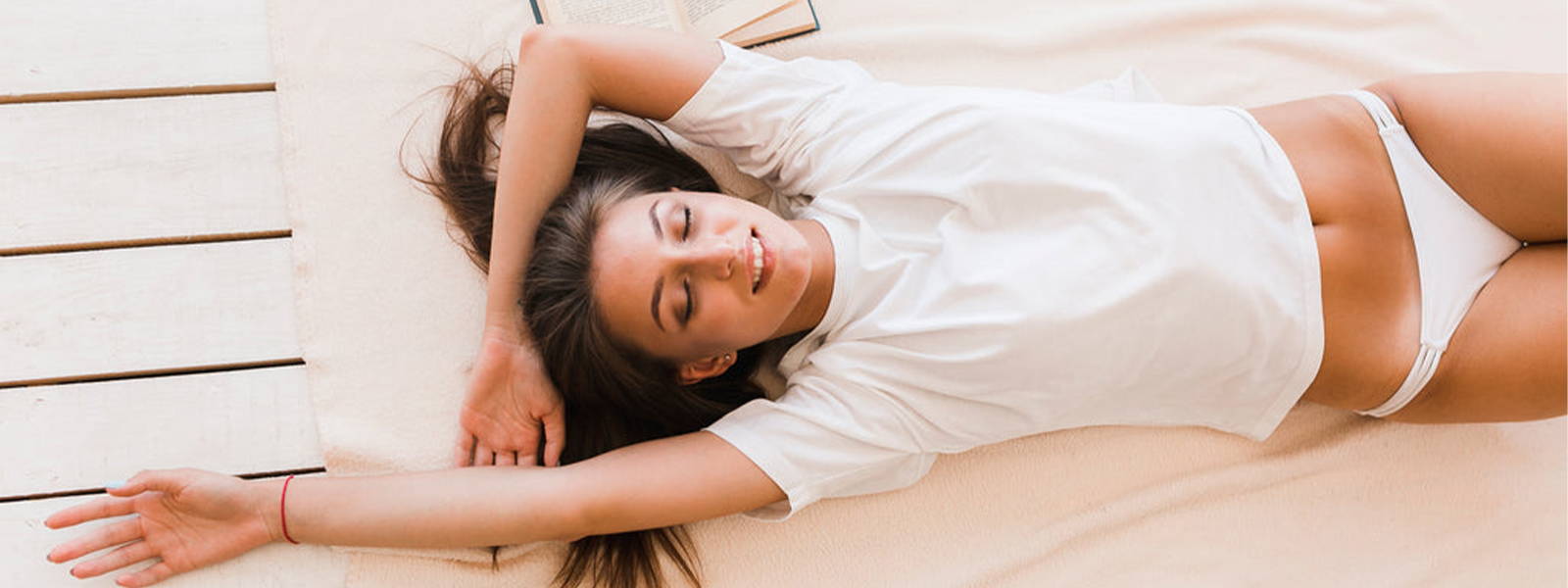
LE SOMMEIL, L’AMI DE LA PEAU
Quoi de mieux que les vacances pour profiter, sortir, s’évader mais aussi se reposer ? Grand bien nous fasse, les congés sont certainement la meilleure excuse pour prendre soin de soi et retrouver la durée idéale de nos nuits, loin du bureau et du stress qu’il engendre. Exit les réveils en continu et bonjour les nuits bien méritées. Pour autant, dès le retour, il s’agit de garder ce bon sommeil retrouvé et d’en extraire au mieux les bienfaits pour notre bien-être personnel mais aussi pour notre peau. En effet, les études ont démontré qu’un sommeil de qualité a un impact majeur sur la qualité de la peau. À nous le teint healthy et lumineux ! Voici tout ce qu’il faut savoir sur le mécanisme de ce dernier pour (enfin) retrouver des nuits de qualité.

NABILA
Août 2019
1. COMMENT EST STRUCTURÉ NOTRE SOMMEIl ?
Si la quantité de sommeil est importante, sa qualité l’est tout autant pour le bon fonctionnement de notre corps et de notre esprit. Lorsque nous dormons bien, notre santé physique ainsi que l’activité de notre cerveau sont rechargées. À échelle quotidienne, cette restauration est primordiale.
Lors d’une seule nuit, le sommeil se divise en 4 à 6 cycles allant de 1h30 à 2h chacun. Un chiffre qui varie évidemment en fonction des personnes. Deux phases interviennent lors de chaque cycle. Tout d’abord, une phase lente avec mise au ralenti des fonctions mentales pendant 1h30 en moyenne. Intervient ensuite une phase de sommeil paradoxal lors de laquelle, l’activité cérébrale est intense bien que le dormeur bénéficie d’un sommeil profond. Elle dure en moyenne 15 minutes.
Cependant, le sommeil le plus réparateur intervient généralement lors des deux premiers cycles, soit les 3 premières heures de sommeil. Par la suite et ce, au cours de la nuit, le sommeil devient de plus en plus superficiel et le sommeil paradoxal augmente. C’est lors de cette phase que l’on rêve, ce qui assure une bonne santé physique et psychique. Hélas, la qualité du sommeil se détériore au fil des années, ce qui explique qu’il n’y a rien d’anormal à se réveiller une à deux fois pendant la nuit à partir de la quarantaine.
2. QUE SE PASSE-T-IL DANS NOTRE PEAU DURANT LE SOMMEIL ?
Au cours de la journée, chaque organe du corps est soumis à différents facteurs de stress. C’est donc la nuit que ces derniers récupèrent via le sommeil. Dans ce registre, il en est de même pour l’épiderme. Lorsque nous dormons, les organes, les tissus mais également les cellules en profitent pour se régénérer et relancer leur production. Il s’agit donc d’une phase de repos indispensable pour notre peau qui redouble d’efforts pendant que nous nous reposons.
Il se trouve en effet que cette dernière agit différemment le jour et la nuit. Selon la dermatologue Laurence Netter, « elle agit le jour comme une barrière protégeant de la pollution, du soleil et de la pénétration des particules. Mais la nuit, elle se régénère car le nombre de multiplications cellulaires est à son maximum. Entre minuit et deux heures du matin notamment, sa perméabilité est plus importante ». Cela est dû à l’augmentation du débit sanguin lors de la phase de sommeil paradoxal qui n’est autre que la source d’irrigation et de réparation de notre peau. Ainsi, une carence en sommeil va se traduire par une perte d’hydratation, d’élasticité, d’oxygénation et de réparation. La peau est alors terne, sèche, rêche, marquée de ridules et plus grasse.
Une nuit de sommeil de moins de 7heures ne permet justement pas au corps d’évacuer tout le stress de la journée. L’hormone de stress, le cortisol, chargée de retomber pendant la nuit, reste par conséquent élevée dans le sang. Et alors que la nuit devrait porter conseil, le corps se retrouve à la place confronté aux effets du stress qui modifie l’immunité de l’organisme et de la peau. À trop grande quantité, cette même hormone stimule la dégradation du collagène, la protéine responsable de la souplesse et de la fermeté de la peau.
En cas de stress chronique, ce même cortisol voit sa sécrétion s’emballer, générant de l’inflammation et causant eczéma, psoriasis ou encore acné.
3. LES SOINS POUR RATTRAPER LES EFFETS D’UNE MAUVAISE NUIT
De tous ces processus expliqués, la nuit reste donc le meilleur moment pour offrir un peu de bon temps à la peau. Entre minuit et deux heures du matin, cette dernière entre en sommeil profond et le processus de réparation cutanée atteint son pic. À ce stade, la différenciation et la réorganisation cellulaires sont intensifiées, la fonction barrière de la peau se répare, la microcirculation s'accélère et la desquamation augmente. Il s’agit donc d’opter pour des soins hautement concentrés en actifs anti-inflammatoires et réparateurs conçus pour recréer les effets du sommeil sur la peau et afficher, quoiqu’il arrive des traits reposés au réveil. Crèmes, masques et sérums de nuit contenant des huiles essentielles sont donc les bienvenus car ces dernières sont de véritables vecteurs de pénétration d’actifs en profondeur. Ils s’utilisent le soir sur une peau propre et démaquillée et seront absorbés par la peau qui s’avère plus perméable. Et pour préparer au sommeil et relâcher les muscles faciaux, le massage cutané s’avère être un super allié.
Chez L'ODAÏTÈS, notre sérum concentré en actifs réparateurs permet un apport important en nutriments. Ces mêmes nutriments seront véhiculés en profondeur dans le derme à l’aide du pouvoir des huiles essentielles évoquées plus haut avec d’un côté le romarin au pouvoir antioxydant et de l’autre le néroli, au pouvoir anti-inflammatoire.
4. LES OUTILS POUR VOUS AIDER
Pour rendre sa nuit plus belle, plus douce et surtout de meilleure qualité, il existe quelques clés. Tout d’abord, il faut prendre l’habitude de supprimer tous les excitants comme le thé et/ou le café dès 14 heures environ, surtout si le stress fait son apparition. De plus, une chambre correctement aérée, une lumière tamisée et l’éloignement des écrans lumineux aideront le sommeil à se faire sentir. Pour terminer, sachez qu’il existe des applications pour vous aider à analyser vos nuits comme Sleep Better ou i Sommeil, qui enregistrent les différents cycles et fournissent un historique à étudier. D’ailleurs, certaines entreprises ont fait le pari des appareils connectés dédiés au sommeil comme Morphée Box qui lutte contre les insomnies.
